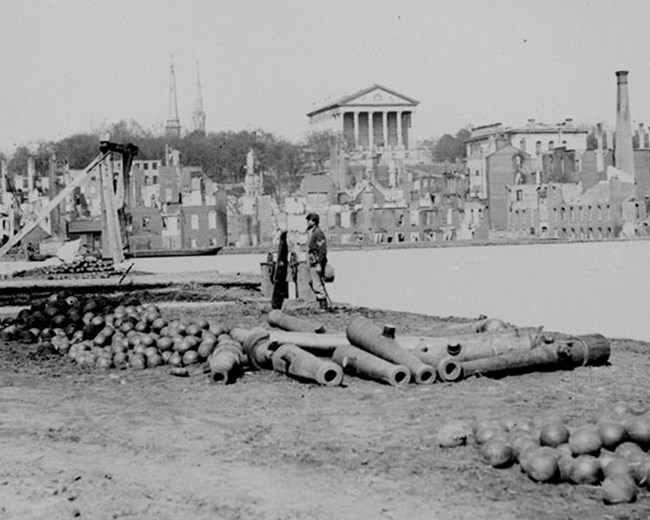
Virginia began making preparations for war early this month. Troops under the command of Colonel Thomas Jackson (of the Virginia Military Institute) removed machinery and tools from the arsenal and gun factory at Harpers Ferry, moving them deeper into Virginia. In Washington, Union troops poured into the city, setting up camps around the capital. Massive fortifications began to rise around the city. This month the upper south states seceded: Arkansas, Tennessee and North Carolina, all joining the Confederacy. On the 21st the Confederate government moved the capital to Richmond. It was much closer to Washington, D.C., in fact only 90 miles away. Richmond was an older and more established city than Montgomery; and Virginia gave the new government a measure of prestige that Alabama lacked. Montgomery was still somewhat of a frontier town with poor rail connections .Richmond was well connected by rail, water, telegraph, and highway.It also had the Tredegar Iron Works, one of the few industrial centers in the South capable of producing heavy artillery guns. Virginia also had obvious ties to the Founding Fathers: Washington, Jefferson, Henry, Madison, Monroe, and others.Contemporaries called Virginia the "birthplace of states and statesmen. " Virginia's voters officially ratified the secession decision on the 23rd -- 125,950 to 20,373. The very next day Union troops crossed over the Potomac from Washington and seized Alexandria, the first incursion into Virginia. The city would be in Federal hands for the rest of the war. Back in Appomattox County that same day, the Appomattox Rangers, a local cavalry unit, formed at the county courthouse under the command of Captain Joel W. Flood. Later the Rangers became Company H of the 2nd Virginia Cavalry Regiment. Flood, one of the wealthier and more educated men of the county, had attended Emory & Henry College and the University of Virginia. Camp Lee, established in Richmond, became a gathering site for the newly raised troops arriving from all across Virginia. Here local companies were organized into regiments. Many Southside companies formed the 18th Virginia, which we will follow through war. Company A was the Danville Blues, B were the Danville Grays, C were the Nottoway Rifle Guards, D were the Prospect Rifle Guards (from Prince Edward County), E were the Black Eagle Rifles (Cumberland County), F were the Farmville Guards, G were the Nottoway Guards, H were the Appomattox Grays, I were the Spring Garden Blues (Pittsylvania County), and Company K were the Charlotte Rifles. On May 25th the men of the 18th Virginia moved to Manassas, where Confederate forces were gathering to defend the state. General Pierre G.T. Beauregard had assembled an army here, just thirty miles from Washington. On the 28th the Hampden-Sydney Boys left Farmville for training camp at Richmond. Hampden Sydney President John M.P. Atkinson captained the unit, made up of 101 young men from the college as well as the Union Theological Seminary. As preparations accelerated on both sides, citizens began to wonder when and where the battle would be fought. North and South, both sides expected one climactic battle to decide the war. |
Last updated: March 31, 2012
